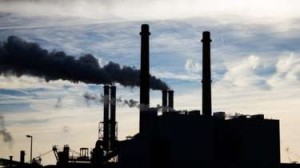BBC NEWS
Science & Environment
By Roger Harrabin
BBC environment analyst

Image copyrightThinkstock Image caption How fast are countries prepared to decarbonise their economies?
Global experts are meeting in Morocco to assess the adequacy of politicians’ pledges to protect the climate.
So far, about 150 nations have promised the UN to curb (NB: Not cut) CO2 emissions, but analysts say the pledges are not enough.
One think-tank, Climate Analytics, estimates promises so far will lead to a global temperature rise of about 2.7C – well over the 2C “safety threshold”.
At the Morocco meeting of 36 nations, governments will judge the pledges for themselves.
The EU proposed at previous climate talks that the UN should hold a meeting before the Paris climate summit at the end of next month to determine the size of what’s known as the “emissions gap” – the shortfall between actions governments have promised and actions scientists say are needed.
China blocked that proposal, nervous of being asked to improve on its long-term climate plan, which it already considers more than adequate.
So the EU has taken the initiative to host the Rabat gathering in conjunction with the hosts of next year’s UN climate talks, Morocco.
The US and India will take part with others, including the UK, Germany, several African nations and Australia, which has been heavily criticised over the adequacy of its pledge on emissions.
‘Damaging impacts’
Miguel Arias Canete, EU commissioner for energy and climate action, said the meeting would not be “a punitive exercise which points its fingers at other countries”. But China has not been persuaded.
The pledges process is the first time that rich and poor nations have all agreed action plans to tackle climate change together. It is a marked departure from previous “rich versus poor” climate negotiations, and already is being hailed as a diplomatic success (albeit a scientific failure).
Nick Nuttall from the UNFCCC, the UN body overseeing the Paris talks, told BBC News: “Without these action plans, we would be heading for a much higher temperature rise – 3C, 4C… some would say even more. What has been put on the table is a floor, not a ceiling, and it is bending the curve quite dramatically.
“We are talking about changing two centuries based on the burning of fossil fuels into a world where fossil fuels will become something of the past. So this is an amazing start.”
Bill Hare from Climate Analytics told BBC News: “There is a lot of progress but it’s not enough. A lot of countries are not going as far as they could – or even as far as would be in their long-term interests.”
He said if governments managed to create policies to deliver their current pledges, “we estimate median warming of around 2.7C, likely below 3C.
“After 3C, we see severe risk to food production, particularly in regions of the world that are already extremely vulnerable to hunger and malnutrition. At 3C, for many parts of world – including Europe, America and Australia – water will be severely at risk.
“Two degrees warming would avoid some of the worst problems, particularly for food production and drought. It would lower the level of sea-level rise, heatwaves and damage to economies. But it is still not safe for many regions.”
Future uncertainty
Indeed, some vulnerable states say global temperature should be allowed to rise no more than 1C – a level we have almost reached already.
Mr Hare’s projections are based on computer model findings from the global climate assessment authority, the Intergovernmental Panel on Climate Change.
Some thinkers believe these models exaggerate likely warming. Others warn the models can’t foresee potentially irreversible sudden shifts in the climate.
Governments have collectively resolved that the risks of dangerous climate change are so huge, it’s imperative to cut emissions, but there is a divergence between what the pledges appear to promise and real investment trends.
Mr. Hare said he was very worried about the rising trend of coal in South-East Asia, which he said could keep emissions high for many decades to come.







